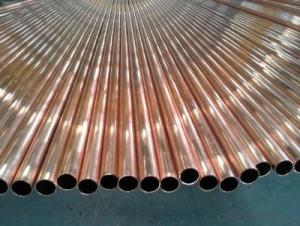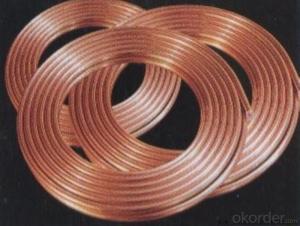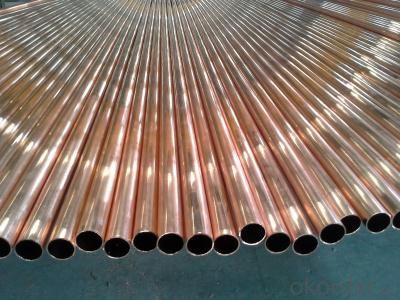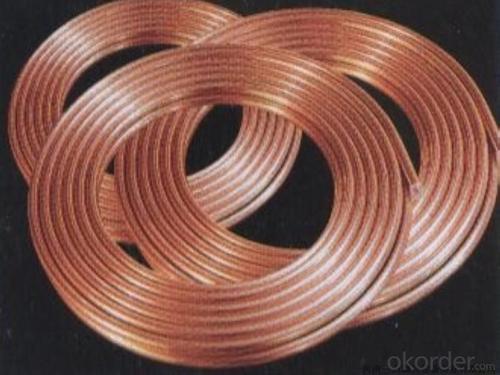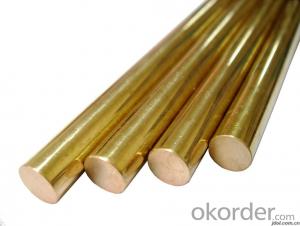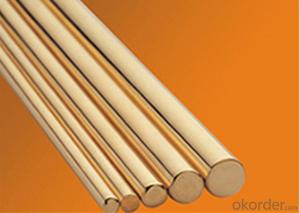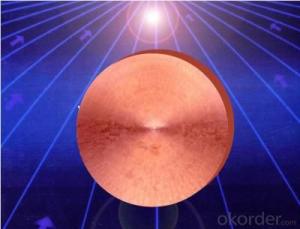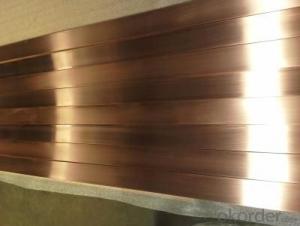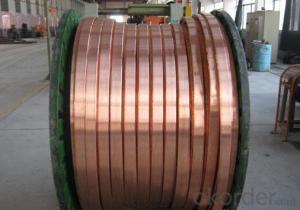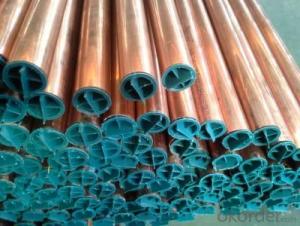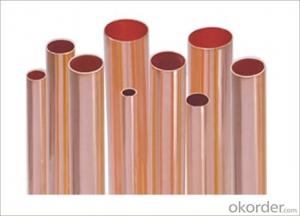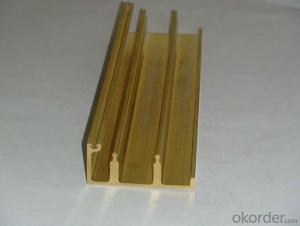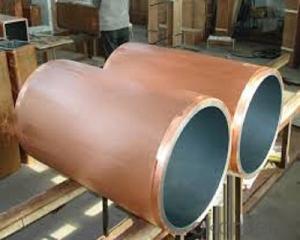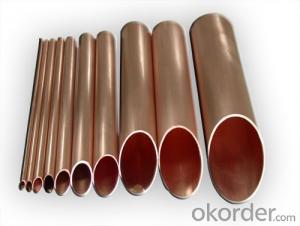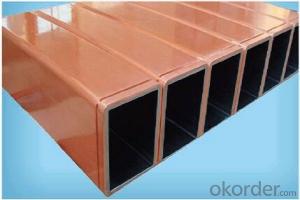High Performance Refrigeration Copper Pipe for Refrigerating System
- Loading Port:
- Shanghai
- Payment Terms:
- TT OR LC
- Min Order Qty:
- 500 kg
- Supply Capability:
- 10000 kg/month
OKorder Service Pledge
OKorder Financial Service
You Might Also Like
Name:High Performance Refrigeration Copper Pipe for Refrigerating
| Model: | P2、TU1、TU2、T2 |
| Brief: | Mainly used in refrigerating system of air conditioners; high precision and pressure-resistant product manufactured through extrusion, rolling, drawing, surface treatment, and heat treatment, usually processed into finned refrigeration pipe and other refrigeration devices. |
Type Specificationss:
Item | air conditioner copper pipe |
Type | straight copper pipe,pancake coil copper pipe,capillary copper pipe |
Standard | GB/T1527-2006,JIS H3300-2006,ASTM B75M,ASTMB42,ASTMB111,ASTMB395, ASTM B359,ASTM B188,ASTM B698,ASTM B640,etc |
Material | C10100,C10200,C10300,C10400,C10500,C10700,C10800,C10910,C10920, C10930,C11000,C11300,C11400,C11500,C11600,C12000,C12200,C12300, C12500,C14200,C14420,C14500,C14510,C14520,C14530,C17200,C19200, C21000,C23000,C26000,C27000,C27400,C28000,C33000,C33200,C37000, C44300,C44400,C44500,C60800,C63020,C65500,C68700,C70400,C70620, C71000,C71500,C71520,C71640,C72200,etc |
Shape | Round,Square,Rectangular,Oval,half-round |
Outside diameter | 4.76-28.58mm |
Wall thickness | 0.4-1.5mm |
Length | 1m,2m,3m,6m,or as required |
Hardness | 1/16 hard,1/8 hard,3/8 hard,1/4 hard,1/2hard,full hard,soft,. |
Surface | mill,polished,bright,oiled,hair line,brush,mirror,sand blast,or as required |
Price Term | Ex-Work,FOB,CNF,CFR,CIF etc |
Payment Terms | TT,L/C etc |
Export to | Singapore,Indonesia,Ukraine,Korea,Thailand,Viet Nam,Saudi Arabia,Brazil,Spain,Canada, USA,Egypt,Iran,India,Kuwait,Dubai,Oman,Kuwait,Peru,Mexico,Iraq,Russia,Malaysia,etc |
MOQ | 2 tons |
Package | Standard export package ,or as required. |
Application | Copper pipe have strong, corrosion resistant properties, and become a modern contractor in all of commodity house pipes, heating, cooling water piping installation of choice |
Contact | If you have any question ,please feel free to contact me we are sure your inquiry or requirements will get prompt attention |
Usage: Mainly used in refrigerating system of air conditioners; high precision and pressure-resistant product manufactured through extrusion, rolling, drawing, surface treatment, and heat treatment, usually processed into finned refrigeration pipe and other refrigeration devices.
Production Equipment
750-1500kg main frequency induction copper melting furnace, 80MN water seal extruder, LG60 high speed two-roll cold pilger mill, straight-line wire-drawing machine, copper tube/pipe straightener, polisher, 84′ copper coil winding machine, straightening-cutting & pancake coiling machine, thermoplastic packaging machine, 1.2T continuous bright annealing furnace.

80MN extruder

Continuous bright annealing furnace
Testing Devices
spectrum analyzer, atomic absorption analyzer, spectrophotometry, analytical balances, metallurgical microscope, eddy current flaw detector, metal tensile testing machine, eddy conductivity instrument.

Hardness tester

Spectrum analyzer

Metallurgical microscope

Metal tensile testing machine

Atomic absorption analyzer
Process
refined copper — smelting & casting — extrusion — rolling — drawing — straightening-cutting/forming of pancake coil — bright annealing — packaging — finished goods.
Standards
GB/T 1527-2006 Drawn tube of copper and copper alloys
GB/T 16866-2006 Dimensions and tolerances of copper and copper alloy seamless tubes
GB/T 4423-2007 Copper and copper-alloy cold-drawn rod and bar
GB/T 5231-2001 Wrought copper and copper alloys chemical composition limits and forms of wrought products
GB/T 5585.1-2005 Copper or aluminium and its alloy bus bars for electrical purposes—Part 1:Copper andcopper alloy bus bars
GB/T 17791-2007 Seamless copper tube for air conditioner and refrigeration equipment
GB/T 19850-2005 The seamless round copper tubes for electrical purposes
GB/T 26024-2010 Seamless copper and copper alloys tube for valves on air-conditioning and refrigeration system
ASTM B280-2008 Standard Specification for Seamless Copper Tube for Air Conditioning and Refrigeration Field Service
EN 12735-1:2001 Copper and copper alloys Seamless,round copper tubes for air-conditioning and refrigeration Part 1:Tubes for piping systems
EN 12735-2:2001 Copper and copper alloy – seamless round copper tube/pipe for air-conditioning and refrigeration system – for equipment
JIS H3300-2009 Seamless copper and copper alloy tube/pipe
- Q: I am taking chemistry and I am wondering what makes rocks different from gold, silver, and copper? Like the difference between minerals and those elements.
- The other John has it right but there's something to clear up. Yes, feldspar and galena are minerals. They are pure compounds that form crystals. Like table salt is a pure compound - the mineral halite is table salt in nature. Rocks are ~mixtures of minerals~ by definition. Analogy: a fork is a mineral, a knife is a different mineral and a spoon is another, different mineral. Throw a handfull of each into a paper bag and shake it up, and that's a rock. By definition.
- Q: Is there a glue or putty like product one can use as a temporary fix for a leaky pipe?
- Odd coincidence. I just now saw a TV commercial by the guy who does Oxy Clean, among other things, selling an Epoxy stick that slices then is kneaded and applied. Certainly Plumbers putty might have a modest effect, but the issue is that the leak is being fixed externally, and pushing against anything that is used to try to stop it. Temporary is likely; better would be drain the pipe and solder the leak.
- Q: I'm doing a project right now, listing the pros and cons of various types of pipe, problem is I cannot think of a single pro for copper pipe. I can think of many many cons (cost, installation time, etc etc) but I'm having trouble thinking of a reason to use it over the numerous plastic pipes used for water supply. Thanks in advance for any help.
- there is no reason not to use CPVC for your water supply and PVC for your drains. especially with the high incident of copper theft at construction sites, even small ones. just make sure you check local codes.
- Q: the reaction between Cu and HNO3 is clearly unusual. But is my explanation and understanding for why they react correct"the HNO3 is an oxidizing agent thus turning Cu to Cu2O. In the form of copper oxide, the reaction between Cu and HNO3 will happen?"--if it is wrong may someone please explain why the reaction occurs
- Hi John: The reduction potential for Cu (+0.34 V) is above that for H2 (0.00 V) and so copper will NEVER displace H2 from dil HNO3 (I've seen several times on this forum views to the contrary). Conc acids however have a whole different chemistry to dil strong acids. In very conc HNO3 (i.e., 100%) Cu is passive for reasons not understood but may be due to a protective CuO coating being formed. In conc HNO3 it is a strong oxidizing acid. I knew the rxns of Cu with somewhat less conc HNO3, but after looking in my texts the conc was only given for the NO production (C&W) [1]. Then I recalled seeing a video of Cu and conc nitric and here it is [2] with equations: Cu(s) + 4HNO3(aq) ——> Cu(NO3)2(aq) + 2NO2(g) + 2H2O(l) They are obviously using commercial conc HNO3 (~70%, ~16M). In the next exp they say dilute HNO3 but that isn't true (C&W says 8M HNO3) which I recall is about right. 3Cu(s) + 8HNO3(aq) ——> 3Cu(NO3)2(aq) + 2NO(g) + 4H2O(l) Well there's another one solved! Cheers, drp
- Q: I‘ve noticed that if the pipe bends at all coupling, it leaks. Now, I can force the pipe to stay straight and that‘s not a problem. My concern is, does this mean that the coupling is not fitted properly, or do they just do this if the pipe is not straight at the joint? I just want to be sure that when it get cold outside again that it‘s not going to start leaking in the middle of the night.
- Sounds like your emissions sensor is sending a bad signal this could make the care send an inappropriate combination of gas and air into the engine causing it to burn incorrectly this could be your problem.
- Q: I have a lab investigation due in a couple of days and I need some help. I've been asked to find a procedure to make Copper (II) acetate from 1g of pure copper fillings (formulas and everything). I have searched everywhere to no avail. Please help me?
- not sure what you need but Cu+2CH3COO -- Cu(CH3COO)x2 if my math is right (which it rarely is) 1.8 grams of acetate is needed to react with the copper ? since it's a 1 to 2 reaction one mole of Cu needs 2 moles of acetate since you have roughly .015625 mol of Cu you would need .03125 mols of acetate, since acetate (C2H3O2 which is sometimes how it's written) is roughly 59 g per mol .03125x59 is 1.8 hope this helps
- Q: A piece of copper metal (specific heat 0.385J/g degree C ) at 86.5degree C is placed in 50.0g of water at 16.4 degree C. The metal and water come to the same temperature of 23.9 degreeC
- Hello ssssss, your question comes under the category of physics, but still its a simple one. Here's how to solve it: We know that, In thermal equilibrium, Heat lost by a hot body equals heat gained by a cold body. Here, the hot body is the piece of copper, since is temperature is higher as compared to water. The common temperature 't' attained by both is 23.9 degrees C. So, Let m(copper) be the mass of copper. So we have the following parameters: t = 23.9 degrees C m(copper) = ? c(copper) = .385 J/g degrees C t(copper) = 86.5 degrees C m(water) = 50g c(water) = 4.2 J/g degrees C t(water) = 16.4 degrees C So, heat lost by hot copper metal = heat gained by cold water. m(copper) x c(copper) x ( t(copper) - t ) = m(water) x c(water) x ( t - t(water) ) m(copper) x 24.101 = 1575 Or, m(copper) = 1575/24.101 m(copper) = 65.34999 g = 65.35 g Wasn't it simple! Hope my steps were clear to you By W@W.
- Q: House is bank owned, wires clipped from electrical box, missing copper pipes from furnaceand the furnace could possibly be missing as well.We are looking to buy this house. It is QUITE CHEAP but we are looking at what it could possibly cost to repair all of this.1. How much does a furnace cost (about 1800 sq ft house)2. How much does it cost for the copper piping that is missing from the furnace?3. How hard and is it costly to fix the clipped wires from the electrical box?Everything else in the house is great, it‘s just that stuff. I know a bank will not approve a loan if the furnace is missing along with the copper pipes and the wires clipped at the electrical box.How much am I looking at out of pocket for this house before we can even move in? We live in PA and aren‘t sure what the laws/regulations are. ANYTHING would help us.Thank you!
- Wire loss does not sound like it would have even been worth considering as it soon goes into walls., so not a long piece if I were considering on taking it. I think they did more work than what it was worth.HOWEVER: a certified electrician must do the work and sign off on the job as it normally needs to be inspected to be sure the electrician did the job correctly. This protects you. So you can get fire insurance from insurance company iF the house were to catch on fire, the insurance company is one of the first ones on the property after the fire and they will search for a point of ignition. If it is in the wiring that is not certified (oh yeah, they will have records) it gives them the right to refuse payment. Furnace goes the same way generally speaking. If the furnace is missing then you can start with a new system entirely such as forced air heating system. Furnaces are going to cost about the same no matter which system you buy. You will need tin bashers to evaluate whether they can install the system.or just a heating contractor to evaluate and judge which is easier to install (the old system or go with a different system) He should be able to give you an approximate cost for it and time period. So, the only difference is who hires the contractor the bank or you Furnace is needed because you do not want the plumbing that has water inside to FREEZE. That can crack porcelain or split metal pipe or plumbing joints are broken open in the walls Now, that is a mess. I would not want that to happen and spot heaters just does not cover the whole house especially iF you are in an area that Freezes. Most likely the bank would consider the hiring of the repair contractor for you MAY be the only buyer interested.
- Q: If you dissolve 0.135g of copper in nitric acid and dilute it to 100.0 mL with water, calculate the concentration of Cu^2+ in the resulting solution.Please help me with this question
- Look up the atomic weight of copper in the periodic table. You can assume this the same as the molar mass of copper and use it for the next step. The electrons are negligible, so you can ignore the mass difference between the ion and elemental Copper. Divide the mass of copper by the atomic weight to get the number of moles of copper. Divide the number of moles by the volume of water in liters (100mL = 100 x 10^-3 L) to get your concentration in moles per liter There it is, step by step.
- Q: My Teacher gave us homework, but im still having some trouble getting to the answeres, she gave us the answers ( she just to see the work) but I cant seem to get the right answer ( the answer is 8.36x10e3) can someone help show me hoe to get it ( we also have to use significant figures and round but i just want to know how to get to the answer)
- Your question is not complete. You have 5.03 *10^21 atoms of Copper? and Answer is 8.36 * 10^3. Can you be more specific like the moles, molar mass. Can you please type the question given to you by your teacher! Edit: Ok! You know 1 mole = 6.02*10^23 atoms So using the conversion 1 mol / 6.02*10^23 atoms 5.03 * 10^ 21 atoms of Copper * 1 mol / 6.02 *10^23 atoms of Copper 8.36 * 10 ^ -3 moles of Copper. Now i actually understand your question. See when you press e in the calculator it is already assumed to be 10 . So if your typing 6.02*10^ 23 in calculator just put 6.02 e 23 and it should shoud be done. e in calculator is 10^ . So what you would do is type like this in your calculator 5.02 e21 / 6.02 e23 and then you will get your answer maybe as 0.0083554817 but you need just 3 sig figs. so you can write either as 0.00836 or some calculators give you as 8.3554817 e-3 . So dont worry. just remember not to add that 10 after you entered the e. Just add the power and you should be fine! Hope it helps! Good luck! Reply back if its still confusing you!
Send your message to us
High Performance Refrigeration Copper Pipe for Refrigerating System
- Loading Port:
- Shanghai
- Payment Terms:
- TT OR LC
- Min Order Qty:
- 500 kg
- Supply Capability:
- 10000 kg/month
OKorder Service Pledge
OKorder Financial Service
Similar products
Hot products
Hot Searches
